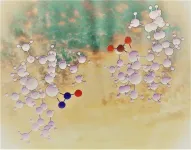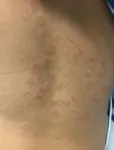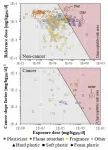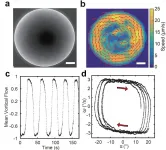How a gene called HAND2 may impact the timing of labor
A study explores the role of HAND2 in human and mammalian pregnancy
2021-02-22
(Press-News.org) BUFFALO, N.Y. -- A new study illuminates how a gene called HAND2 may have a hand in the timing of human labor.
"We don't know why humans go into labor. It's a basic aspect of human biology that we just don't know the answer to, and it's kind of embarrassing that we don't," says senior author Vincent Lynch, an evolutionary biologist at the University at Buffalo. "What happens in many other animals is that as gestation goes on, the level of progesterone keeps going up, and then a few hours before birth, progesterone levels drop to pre-pregnancy levels. Progesterone inhibits contractions, so once you lose it, the uterus starts contracting and the baby is born.
"But in humans, this isn't what happens -- progesterone levels don't drop off. So we need to find another explanation for why labor begins."
The research was published on Feb. 1 in the journal eLife.
Lynch, assistant professor of biological sciences in the UB College of Arts and Sciences, led the study with first author Mirna Marini?, PhD, a postdoctoral researcher in the University of Chicago Department of Organismal Biology and Anatomy.
Co-authors included Katelyn Mika and Sravanthi Chigurupati, both from the University of Chicago (Chigurupati is now at AbbVie).
The evolution of HAND2, placental mammals and pregnancy
Using new and existing datasets the team studied genes that were active in the uterine linings of different animals while pregnant or carrying eggs. Species researched included placental mammals (like humans and armadillos) and marsupials (like opossums and kangaroos), as well as egg-laying species like platypuses (an egg-laying mammal), birds, lizards and a frog.
A comparative analysis showed that the HAND2 gene evolved to be turned on in the uterine linings of placental mammals during pregnancy, but not in those of the other species studied.
"HAND2, which ancestrally plays a role in heart development, evolved to be turned on in the uterus during pregnancy, when things like maternal-fetal communication, maternal immune tolerance of the antigenically distinct fetus, and prolonged internal gestation are important," Lynch says. "Our research suggests that HAND2 may be involved in facilitating some of these processes."
HAND2 and questions about the timing of labor
In addition to tracing the evolutionary history of HAND2 in the context of pregnancy, scientists also investigated the changing levels of HAND2 during gestation.
The team concluded that in humans, the HAND2 gene becomes less active throughout pregnancy, reaching a low as labor nears. This is interesting because HAND2 has previously been shown to play a role in suppressing the activity of estrogen, a process that helps women stay pregnant.
The study also uncovered new details about the activity of HAND2 that suggest the gene may be involved in the timing of labor. As Lynch explains, "A region of the genome far, far away from HAND2 is associated with how long gestation lasts in humans, and we found that it acts as on/off switch for HAND2 in the uterus."
"Given the possibility that dynamic HAND2 expression over the course of pregnancy may be important in regulation of gestation length, it will be exciting to build upon our results further, especially in the context of researching preterm birth," Marini? says.
INFORMATION:
The research team was supported by the Burroughs Wellcome Fund and March of Dimes.
ELSE PRESS RELEASES FROM THIS DATE:
2021-02-22
The reintroduction of 32 bobcats to an island off the coast of Georgia more than three decades ago created an ideal experiment to examine the accuracy of a genetic-modeling technique that predicts extinction of isolated wildlife populations.
That's the conclusion of Penn State researchers who continue to monitor the bobcat population on Cumberland Island National Seashore, and who conducted a study comparing and contrasting the Cumberland Island bobcats to a population of bobcats on Kiawah Island off the coast of South Carolina.
The research was led by Cassandra Miller-Butterworth, associate professor of biology at Penn State Beaver, and Duane Diefenbach, Penn State adjunct professor of wildlife ecology who, as a doctoral ...
2021-02-22
Like its chemical relative carbon dioxide (CO2), nitrous oxide (N2O) is an important greenhouse gas and the dominant ozone-depleting substance emitted in the 21st Century. Consequently, strategies for limiting its emissions and its catalytic decomposition with metals are being developed. A recent study indicates that nitrous oxide can bind to metals similarly to carbon dioxide, which helps to design new complexes with even stronger bonding. This could allow the use of nitrous oxide in synthetic chemistry or help to degrade it to substances harmless to the atmosphere. The results were reported in the journal Angewandte Chemie International Edition as a Very Important Paper on February 17th 2021.
A comprehensive analysis of the global N2O budget has ...
2021-02-22
UNIVERSITY PARK, Pa. -- The COVID-19 pandemic has prompted considerable investigation into how the SARS-CoV-2 Spike protein attaches to a human cell during the infection process, as this knowledge is useful in designing vaccines and therapeutics. Now, a team of scientists has discovered additional locations on the Spike protein that may not only help to explain how certain mutations make emerging variants more infectious but also could be used as additional targets for therapeutic intervention.
"Significant research is underway to examine how the receptor binding domain (RBD) at the tip of the club-shaped SARS-CoV-2 Spike protein attaches to an ACE2 receptor on a ...
2021-02-22
A new study from researchers at the University of Ottawa's School of Psychology has found that using negative emojis in text messages produces a negative perception of the sender regardless of their true intent.
Isabelle Boutet, a Full Professor in Psychology in the Faculty of Social Sciences, and her team's findings are included in the study 'Emojis influence emotional communication, social attributions, and information processing' which was published in Computers in Human Behavior.
Study background: Eye movements of 38 University of Ottawa volunteer undergraduate student participants were tracked and studied, and the volunteers were shown sentence-emoji pairing under 12 different conditions where sentences could be negative, positive, ...
2021-02-22
Philadelphia, February 22, 2021--In April 2020, pediatricians began recognizing a puzzling syndrome in children involving hyperinflammation that results in an array of symptoms, including fever, gastrointestinal distress and rash. The syndrome, thought to be a post-infectious complication of SARS-CoV-2 infection, was given the name Multisystem Inflammatory Syndrome Children, or MIS-C. However, diagnosing the condition has posed challenges, as many of its symptoms, including rash, are common in many other pediatric infections.
In a study published in Open Forum Infectious Diseases, researchers at Children's Hospital of Philadelphia (CHOP) describe the ...
2021-02-22
It has long been known that several chemicals used in plastic toys in different parts of the world can be harmful to human health. However, it is difficult for parents to figure out how to avoid plastic toys containing chemicals that may cause possible health risks to their children.
Regulations and labelling schemes are different across regions and countries, and there is no international agreement on which substances should be banned from use in toy materials. For the most part, regulations and international lists of 'chemicals of concern' in toys focus on certain substance groups with known harmful properties, such as phthalates, but do not cover the wider range of chemicals found in plastic toys.
Researchers from DTU ...
2021-02-22
With the COVID-19 pandemic taking a disproportionate toll on low-income people of color, a research team headed by Marya Gwadz of the Silver School of Social Work at New York University set out to understand the ways the pandemic may put individuals at risk for adverse outcomes, and the ways they successfully adapted to and coped with the emerging pandemic, focused on those from low-socioeconomic status backgrounds who have lived with HIV for a decade or longer.
The team's newly published study explores the effects of COVID-19 on engagement in HIV care, HIV medication use and overall wellbeing during the early stages of the ...
2021-02-22
About 70% of the world's main crops depend on insect pollination. Climate change is already affecting the abundance and distribution of insects, which could cause geographical mismatches between crops and their pollinators. Crops that rely primarily on wild pollinators (e.g., crops that cannot be effectively pollinated by commercial colonies of honey bees) could be particularly in jeopardy. However, limited information on plant-pollinator associations and pollinator distributions complicate the assessment of climate change impacts on specific crops. To study the potential impacts of climate change on pollination of a specific crop in North America, we use the case of open?field ...
2021-02-22
Macrocyclic peptides are promising candidates for pharmaceuticals, but their screening is difficult. Scientists have now developed an easy-to-use, high-throughput screening assay for cyclic peptides with affinity to ubiquitin, a protein that helps to degrade proteins and induce cell death. The results could lead to novel drug candidates against cancer, according to the study published in the journal Angewandte Chemie.
Drugs based on peptides (small proteins) are often too large to pass through cell membranes. To make such peptides more compact and stable--and thus more efficient--researchers are investigating their closed versions, called macrocyclic ...
2021-02-22
This new finding may pave the way for fabricating a new class of self-driven devices and materials, such as the ability to control the rhythmic movement of soft robots without relying on electronic circuits, and for the study of microbial physiology. It has been published in the scientific journal Nature.
A fast growing and interdisciplinary field, active matter science studies systems consist of units where energy is spent locally to generate mechanical work. Active matter includes all living organisms from cells to animals, biopolymers driven by molecular motors, and synthetic self-propelled materials. Self-organisation (the process of producing ordered structures via interaction between ...
LAST 30 PRESS RELEASES:
[Press-News.org] How a gene called HAND2 may impact the timing of labor
A study explores the role of HAND2 in human and mammalian pregnancy





